Over There: World War I Genealogical Research
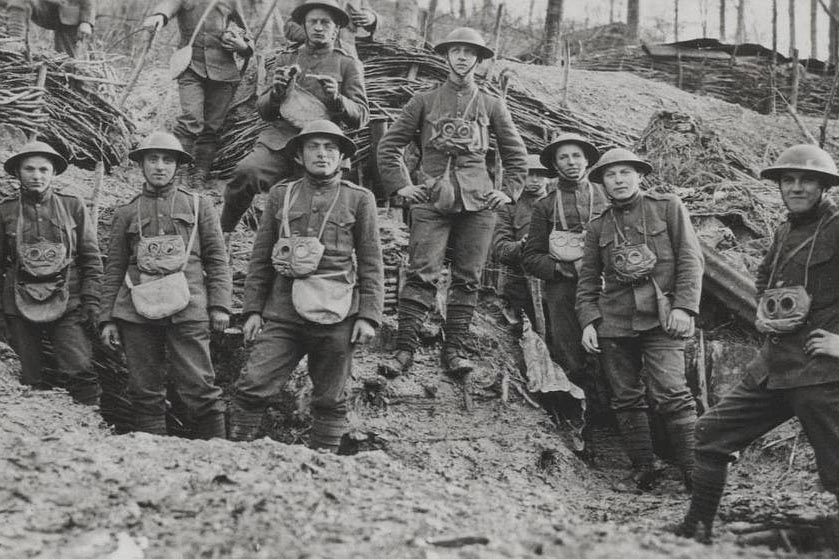
In Flanders Fields
John McCrae – 1872-1918
In Flanders fields the poppies blow
Between the crosses, row on row,
That mark our place; and in the sky
The larks, still bravely singing, fly
Scarce heard amid the guns below.
We are the Dead. Short days ago
We lived, felt dawn, saw sunset glow,
Loved and were loved, and now we lie
In Flanders fields.
Take up our quarrel with the foe:
To you from failing hands we throw
The torch; be yours to hold it high.
If ye break faith with us who die
We shall not sleep, though poppies grow
In Flanders fields.
History of US Involvement
At the eleventh hour of the eleventh day of the eleventh month in 1918, a cessation of hostilities began with the signing of an armistice between Allied forces and Germany after a devastating war lasting over four years. The armistice initially expired after a period of thirty-six days and had to be extended several times. A formal peace agreement was reached only when the Treaty of Versailles was signed the following year in Paris, France.
Prior to World War II, the events of 1914–1918 were generally known as the Great War or the World War; here we’ll call it the Great War. The US had remained neutral for the greater part of this conflict, but finally entered mainly because of the German policy of unrestricted submarine warfare, which not only cost American lives, but paralyzed trade as ships were reluctant to put to sea. This caused food shortages in cities along the East Coast and on March 22, 1917, Congress approved the arming of merchant ships. On April 4, 1917, the US Senate voted in support of the measure to declare war on Germany by a margin of 82-6. The House concurred two days later on April 6, endorsing the measure by a vote of 373-50. The Selective Service Act of 1917 that required draft registration went into effect on May 18, 1917. The US later declared war on German ally Austria-Hungary on December 7, 1917. The first American troops arrived in Europe in June 1917. The US sustained more than 320,000 casualties during WWI and the American Expeditionary Force evolved into an army recognized as one of the best in the world.

But in 1917 the US was not ready for war. On April 6 the US Army was a constabulary force of 127,151 soldiers. The National Guard had 181,620 members. Both the country and the Army were absolutely unprepared for what was going to happen. The US had no process in place to build a mass army, supply it, transport it, and fight it. Americans didn’t see the need for universal service because the Atlantic Ocean seemed to be a pretty good barrier against European military aggression. Americans also had a long history of distrust of a large standing army going back to the Revolutionary War era. Additionally, many recent immigrants disliked the idea of forced national service because for many of them it was the reason they left Europe in the first place. But a draft – or Selective Service – was the only way to go.
If your family has been in the US for over three generations, you may have a relative who served in the Great War. American involvement in this conflict generated abundant documentation of military and non-combatant services by men and women who served in myriad capacities at home and abroad. Today we’re going to identify some of these valuable records and where genealogists can find them so these people can be identified and remembered for service to their country.
The Records
As is true with most genealogical research, your search for evidence of service during the Great War should begin at home. Also check with other family members. Look for newspaper clippings, obituaries, photos, Veteran’s Administration paperwork, discharge papers, family stories, awards, medals – anything that could indicate military or non-combatant service during the Great War. Once you’ve completed the “home search,” it’s time to scout for additional information elsewhere.
DRAFT REGISTRATION CARDS Overall, 24,234,021 men – aliens and US citizens – filled out registration cards for the draft over three registration periods. You can find these cards at Familysearch.org (free) and Ancestry.com ($). The first occurred on June 5, 1917 (men aged twenty-one to thirty-one—men born between June 6, 1886 and June 5, 1896). The second occurred on June 5, 1918 (men who had turned twenty-one years of age since the previous registration—men born between June 6, 1896 and June 5, 1897). Men who had not previously registered and were not already in the military also registered. In addition, a supplemental registration on August 24, 1918, was for men who turned twenty-one years of age since June 5, 1918. The third took place on September 12, 1918 for men aged eighteen to twenty-one and thirty-one to forty-five—men born between September 11, 1872 and September 12, 1900. Each of the three registrations included a different number of questions. Here’s an example from the third registration:
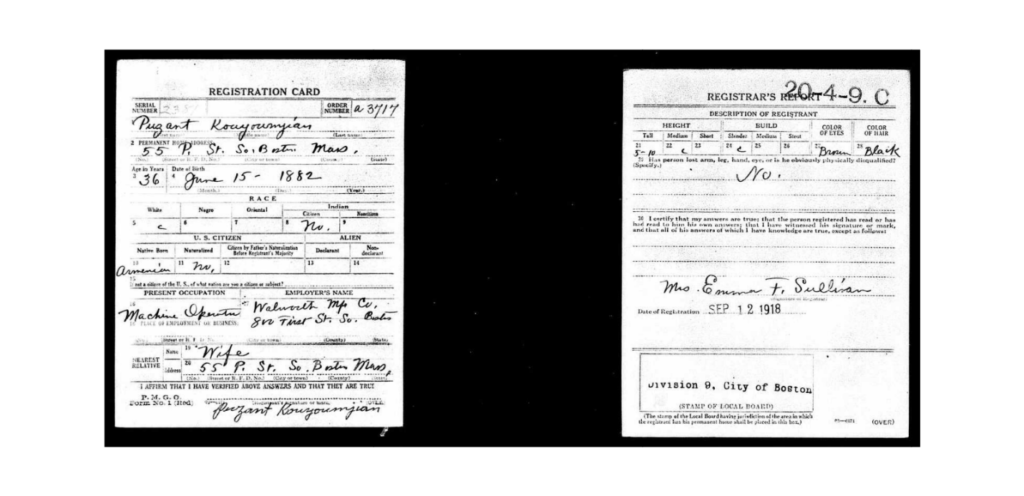
MILITARY PETITIONS FOR NATURALIZATION Many alien soldiers’ naturalizations were facilitated so they could serve in the US Allied Expeditionary Force. The usual first step, the Declaration of Intention, was typically waived to speed up the process. Courts were often located at military bases, and many soldiers filed petitions and were naturalized the same day. Some petitions are available at FamilySearch; go to: FamilySearch -> Catalog -> Keyword -> enter phrase “Military petitions.” Ancestry.com and Fold3.com have images of index cards to petitions browseable by a soldier’s last name, or you can search by given name, surname, base name, or court number. Not all military bases are included.

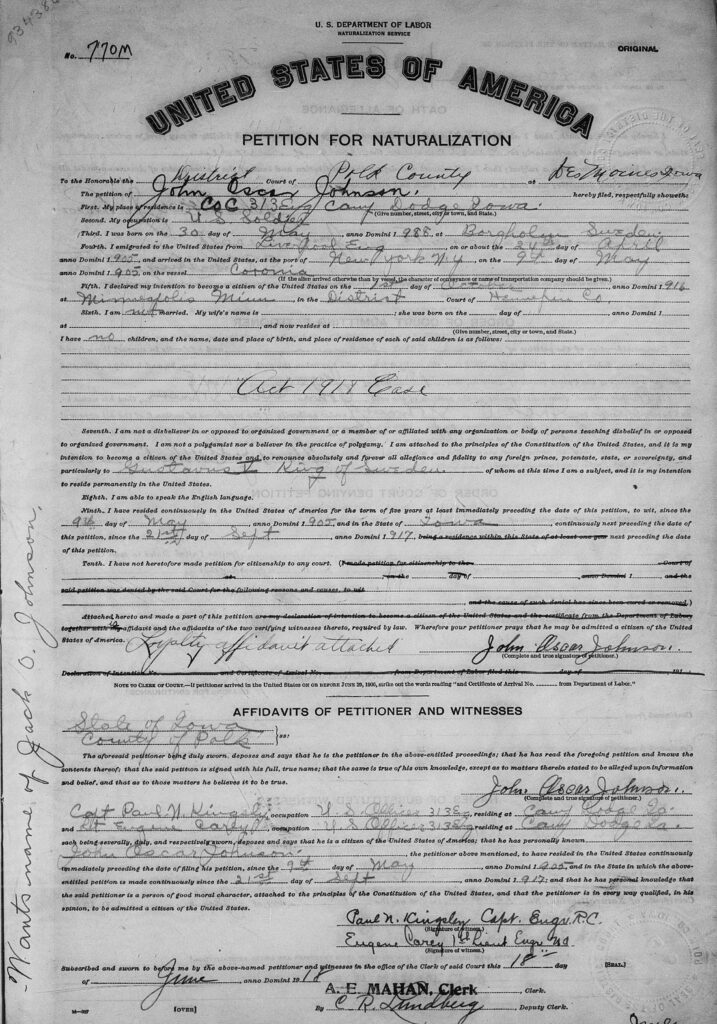
MILITARY SERVICE RECORDS On July 12, 1973, a devastating fire at the National Personnel Records Center (NPRC) in St. Louis destroyed about eighty percent of the records for army personnel discharged between November 1, 1912, and January 1, 1960. There is no index to the records destroyed, so you’ll need to submit an SF 180 form to find out if a record survived. Details about requesting and using the SF 180 are here. You can also use the online ordering form.
Fortunately, it’s possible to obtain some of the military source data that was documented in these lost files from alternate record sources. Since the fire, the NPRC has collected many series of records used for this purpose, but they contain only limited military service information. However, utilized together, they can help reconstruct basic service data. These auxiliary records include Army Morning Reports and Army Unit Rosters (November 12, 1912 to 1959), and Army Officer Pay Cards (1917-1921). While all three record types can be requested from the NPRC, you can access Morning Reports at Fold3.com, currently covering 1912-1939. Morning reports are company-level reports that were filled out each day to reflect status changes of all personnel assigned to the unit. A soldier’s name will appear on the report only if his status had changed in the previous twenty-four hours. For example, here’s a list of men received at a California military camp in July 1918:
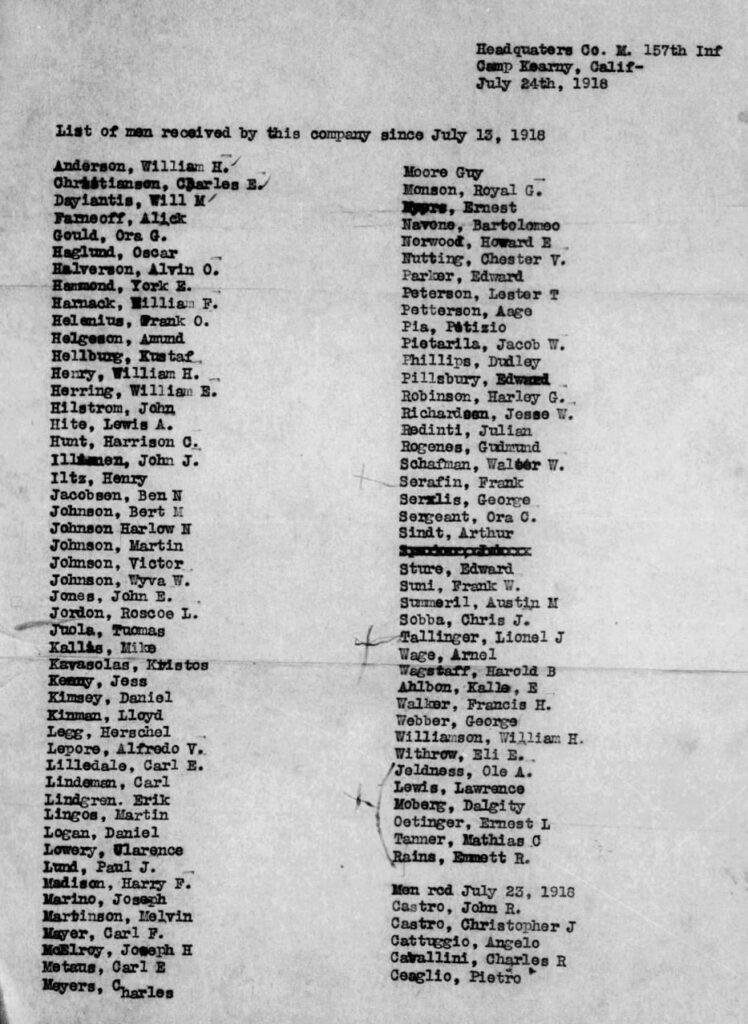
Other Sources
COUNTY COURTHOUSES County courthouses may have copies of enlistments, discharges, and/or photos of residents who served. A 1976 inventory of the Collin County, Texas courthouse contains recorded copies of servicemen’s discharge papers beginning in 1918 which contain significant valuable genealogical information. A 1940 survey of the archives of the city and county of San Francisco, California reveals a collection pertaining to 1918 draft evaders and deserters, giving the name, case number, and nature of offense. Many county inventories were taken prior to World War II, so before visiting a courthouse, be sure to ask if the records you’re looking for are still with the county or are stored elsewhere. Also, be sure to ask if any access restrictions exist.
COUNTY HISTORIES Historical county histories frequently include lists of local men who served in various military conflicts. They may also have biographical information and/or photos. Many of these books have been digitized and are freely accessible online.
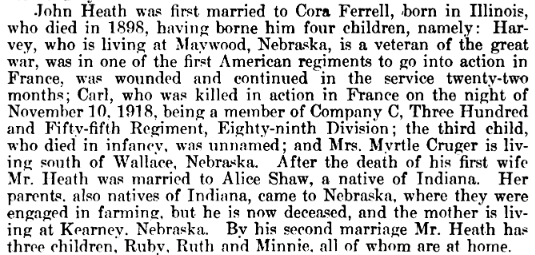
NEWSPAPERS Many local newspapers carried lists of residents who registered and/or served, of men killed or wounded, and other information relating to their military service. Check the Newspapers.com and NewspaperArchive.com databases for free at the library, as well as free newspaper collections databases, such as Elephind and Chronicling America, and The Ancestor Hunt newspaper collection portal.
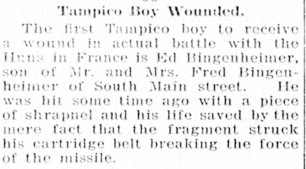
The “Other Side” of the Great War
Of the twenty-four million men who registered for the draft in 1917-1918, more than 64,000 claimed Conscientious Objector (CO) status; 56,830 of these claims were validated by local draft boards, and roughly 20,800 of those men were called up for military service. Either through coercion or persuasion, approximately eighty percent of the 20,800 eventually went to war. Most of the remaining twenty percent served in noncombat roles, and a devoted 1,500 would refuse any sort of service altogether. Four hundred and fifty individuals were court-martialed and sent to Fort Leavenworth in Kansas. Religious beliefs formed the large majority of objections, but other reasons included humanitarian and political opposition to the war.
Anne M. Yoder, archivist of the Swarthmore College Peace Collection, originally created a World War I Conscientious Objector Database as a tool for her personal research on this subject but believed it could be just useful to other researchers. Much of her work was done at Mennonite archives and historical libraries, but the database also includes non-Mennonites.
Records were also kept on draft evaders, delinquent registrants, and deserters. At that time draft evasion was considered shameful and well as illegal. The names of accused evaders were often published in “slacker lists” in many newspapers (see below). Nation-wide branches of the National Archives as well as the NPRC have textual records, not digitized, for delinquents (late registrants) and deserters from various states. This includes an Index to Delinquent and Deserter Forms, 1917-18. State archives may also contain these textual records. All of the North Carolina draft evaders and deserters lists have been digitized, and available in the WW I digital collection of the North Carolina Digital Collections.
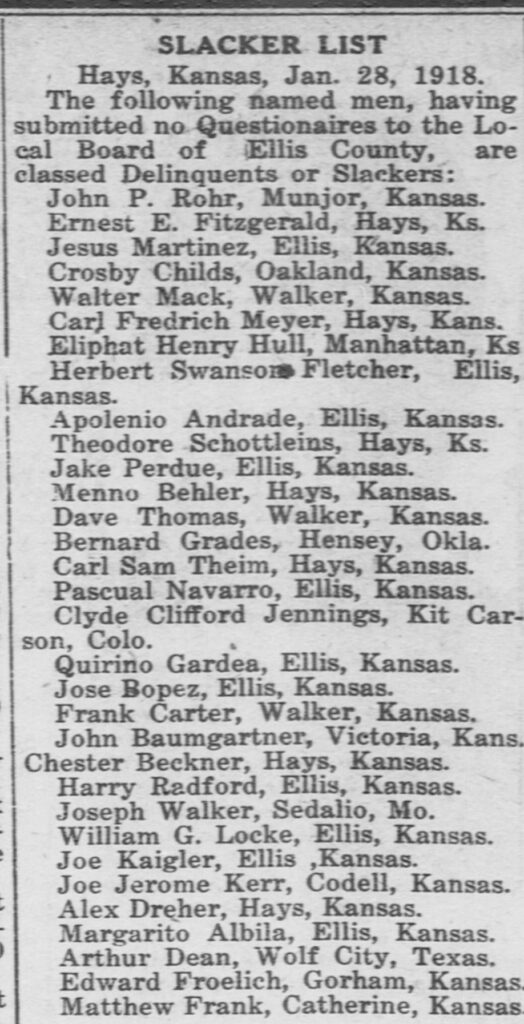

Women and the Great War
Women were a visible element during wartime, serving as volunteers in hospitals and service agencies nationwide. They also helped raise liberty bonds host fundraisers to help support the war effort. Many served as volunteers and nurses for the American Red Cross. Ancestry.com contains a database of American Red Cross Nurse Files, 1916-1959, as well as a Connecticut-based Military Census of Nurses, 1917. Debra M. Dudek’s free e-book World War I Research Guide: Tracing American Military and Non-Combatant Ancestors (listed below) provides a wealth of resources for non-military records pertaining to women during the Great War.

In the late 1920s the US War Department compiled a list of mothers and widows of deceased soldiers killed in World War I and offered to send them to their loved one’s final resting place in Europe. The Ancestry.com database, U.S., World War I Mothers’ Pilgrimage, 1929, contains the names of about 11,000 women who were entitled to make the pilgrimage. Each record provides the name of widow or mother, city and state of residence, and relationship to the deceased. Additionally, information regarding the decedent’s name, rank, unit, and cemetery is provided. You can also read the original government publication.
Some Resources for Research
The resources listed below are but a tiny fraction of those available for Great War/World War I genealogical research. Take full advantage of whatever materials you can access so you can learn more about your family’s World War I heritage and experience.
Published Research Guides:
Dudek, Debra M. World War I Research Guide: Tracing American Military and Non-Combatant Ancestors. Request a free .pdf of this e-book here.
Newman, John J. Uncle, We Are Ready!: Registering America’s Men, 1917-1918: A Guide to Researching World War I Draft Registration Cards. North Salt Lake, UT: Heritage Quest, 2001.
Schaefer, Christina K. The Great War: A Guide to the Service Records of All the World’s Fighting Men and Volunteers. Baltimore: Genealogical Publishing Co., 1998.
Online Resources:
National Archives: Researching Individuals in WW1 Records
Fold3.com ($) or Fold3 Library Edition (free at Grapevine Library). Has sixty publications pertaining to US involvement in WWI.
Ancestry.com ($) or Ancestry Library Edition (free at Grapevine Library). For individual searches, go to Search -> Military –> USA –> State (or omit State). If you subscribe to Ancestry.com, enter this URL to see a list of World War I databases: https://www.ancestry.com/search/categories/war_wwi/
FamilySearch World War I Historical Record Collections. FamilySearch is a free site and accessible anywhere with free registration.
FamilySearch: Over There: World War I Resources Over Here. Includes list of state-published state sources, almost all of which have been digitized.
Online World War I Indexes and Records – USA: A Genealogy Guide
The National World War I Museum and Memorial Online World War I Service Databases
Archive.org. Many free digitized local, state, national resources.
HathiTrust. Not all digitized books available to non-members.
The National WW I Museum (Kansas City, Missouri). America’s leading institution dedicated to remembering, interpreting and understanding the Great War and its enduring impact on the global community. Has on-line collections database; search digital records of global collection that began in 1920. Includes library, photos, posters, letters, women, tanks, etc.
The Doughboy Foundation. Supports programs, projects and activities commemorating and educating the public about America’s role in World War I. Worked with the US WWI Centennial Commission to make the National WWI Memorial in Washington, DC a reality.





Recent Comments